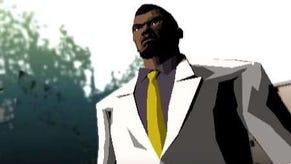Killer 7
Magnificent 7? Killer app? We find out.
Killer 7 is arguably the most audacious piece of game design ever. Not that it's an especially complicated game - we'll try and demystify it in a moment - but simply that it's one of the few games that has been designed around the artwork with very few compromises.
It'd be easy to take one look at Capcom's latest masterwork and dismiss it as a vanity project, but all it essentially does is shift the focus in subtle, intriguing and above all intelligent ways. In some senses it's a game that messes with most of your preconceptions about videogames; about how a game should control, how a game should be viewed, how a game should look. Hell, even the way the game sounds is utterly unique, and the characters... Well, has there ever been a bigger collection of oddballs?
It's a game that'll have you exchanging bewildered glances with onlookers and remarking "what the hell was that about?" But anyone with a soul couldn't fail to fall in love with what it stands for: originality, personality, pushing the boundaries, shock, and taking players to places they've never been before. Places they never knew existed, and certainly never imagined.

Killer 7 is a very special game indeed.
And yet somehow despite all of the arch, arty weirdness bursting out like the blood from Kaede Smith's wrists, the core of Killer 7 is still comfortably familiar; certainly the long-term Capcom fans will spot the long-ingrained design philosophies almost immediately. It's comfortable to know from the very beginning that there's nothing to be afraid of here. Killer 7 is not reinventing the wheel. It's just using it as a Banjo, playing Hendrix licks with its teeth, smashing it onto the stage to shock and setting it on fire and burning its audience alive for kicks.
So, if you're still with us, you're probably due an explanation of who the infamous Killer 7 are exactly. Think Ocean's Eleven, only substitute Clooney, Pitt, Damon, Roberts [pfft, she wasn't one of the eleven -Ed] et al for The Smiths. And we're not talking about those Mancunian miseries Morrissey and Marr, but seven selectable weirdoes who you play as throughout the game; or more accurately the seven personalities/alter egos of a certain Harman Smith, a wheelchair-bound old man who also happens to be the world's most feared assassin and also just so happens to carry a large anti-tank rifle around with him. Subtlety is not his strong point it would seem.
Actually, for a bunch of trained assassins, subtlety is precisely the last thing on the minds of this lot. Killer 7, for reasons not even Capcom seem to have gotten to the bottom of, allows the player to seamlessly select (via the Start menu) from the cast of Harman's mind, if you like. Each one has its own specialty, so in the case of the superfly 'leader' of the pack, Garcian Smith, you come equipped with a silenced handgun. The overtly aggressive Dan comes armed with a custom Magnum, former wrestler MASK De packs a huge punch with his double grenade launcher, Coyote acts as the token locksmith, the albino Kevin (?!) can disappear and prefers throwing knives, the unhinged KAEDE (their choice of SHOUTY block caps, not ours) meanwhile has a handy pistol with a scope, and prefers to shower blood on her foes by slitting her wrists. Don't even ask. And finally, Con has the curious ability to visualise sounds, not to mention run like the wind with a hilarious Billy Whizz style.
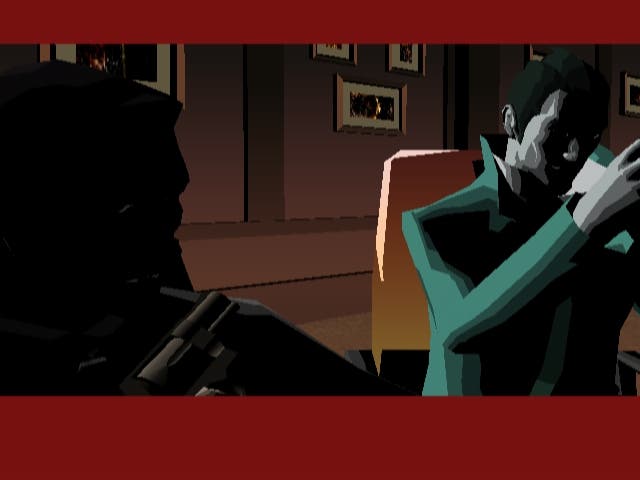
It seems hugely ambitious to even try to attempt to make sense of why you're busy trying to make the best use of the various personalities of Harman Smith, but we'll give it a shot. Essentially Killer 7 has a reputation for getting the toughest jobs done, and is the kind of organisation that Governments will call on when things go tits up and even the Army/CIA/CTU/Delta Force cower in fear at the task in hand.
In the case of Capcom's deeply unhinged game, the year is 2003, and a "new wave of terror is spreading fear and panic throughout the continent". This deadly threat goes by the sweet and innocent name of Heaven Smiles, which are effectively a deadly army of walking bombs - essentially zombie-like shamblers that blow up in front of you if they manage to make contact. This axis of evil is headed up by a certain Kun Lan, and it's the job of Killer 7 to root out his henchmen one by one.
And this is our rather long and winding route to actually telling you about the game. Designed as a series of chapters (the opening one being called 'Angel') the overall goal of each one is to work out how to find the 'boss', and doing so involves solving a bunch of typically Capcom-esque problems; picking up objects, facing off against a slew of deadly Heaven Smiles and then duking it out with a boss.
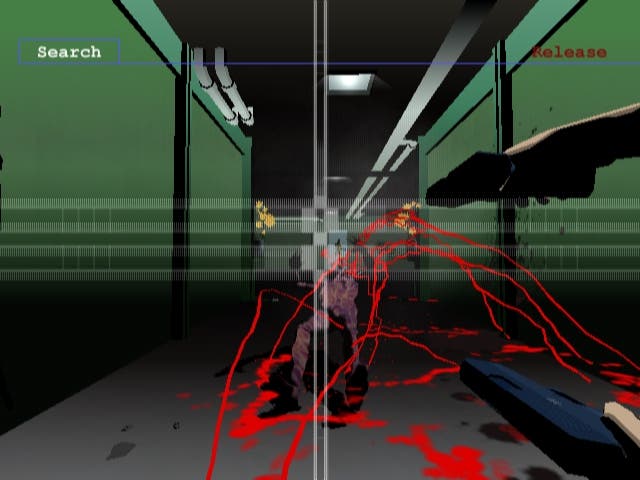
It sounds relatively straightforward when you try and sum up the basics like we've just done, but it probably won't really seem like that to begin with, and here's why: from a control/camera perspective Capcom has pretty much ripped up the rule book, defying conventional wisdom about how you're supposed to do these things, and instead, as we said before, seems to have very much designed the game to look a certain way. First of all the graphic novel art style very much dictates the gameplay - simply by almost shoehorning the actual mechanics around it. It seems abundantly clear that directors Goichi Suda (Grasshopper Manufacture Inc.) and Shinji Mikami (Resident Evil) wanted to remove the camera control from the gamer, and in fact any real movement control at all.
In Killer 7, all you have to do to move is hit the A button to run and B to turn round. That's it. It's jarring as hell to begin with as you'll be haplessly trying to spin the camera and move your character around the environment, but it's no use. But in forcing this upon the player the very deliberate midget's-eye-view camera angle gives the game a very stylistic edge that wouldn't be possible if the freedom was given over to the player.
Run down a corridor and the camera sweeps with you. Reach a junction and a shard of glass option menu slides into view. Point the left stick in the appropriate direction and your character will continue in the direction. Reach a door and the same thing happens - just hit the direction again and you'll enter. See a character or an object to interact with and the same principle applies: the character's name or object appear as a shard in that general direction on the screen and you move the left stick to confirm you want to interact with it. It seems odd to even have to describe how you move around and interact with things in a game these days, but, believe us, it's entirely at odds with anything you'll have ever played.
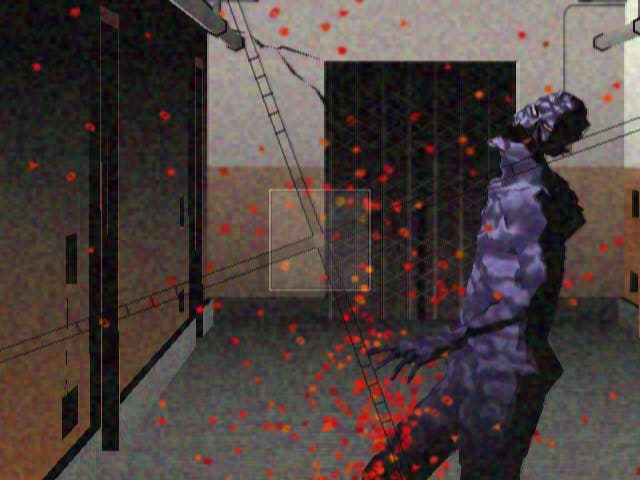
Combat scenarios are a little more traditional, but still take a bit of getting used to. In Killer 7 every time you hear a maniacal cackle, it means a Heaven Smile is in the vicinity, heralding a face-off. At this point it's really important that you simply stop in your tracks and hit the right shoulder button to flip to a first-person view. Hitting the left shoulder button then scans the area, as at this point your enemies will be invisible to you. After that, you'll be slightly unnerved by the fact that they're heading in your direction and are set to explode unless you start pumping some lead into them.
With infinite ammo you can happily just get rid of the initial wave of shambling Heaven Smiles by shooting them several times until they explode in a shower of blood, but each one has a yellow 'weak spot' which, if successfully targeted, kills them in one shot. However, from a distance it's a major task getting the cross hair to line up just so so you'll probably miss more times than is strictly comfortable.
If you do happen to cop an exploding Heaven Smile, the little eye indicator at the top starts to close, indicating your loss of life. But successful kills stock up your blood supply, and can be used to top up your life force at any time, so long as you have some in stock. Combat success also elicits a bunch of (quite strong) expletives from your chosen personality, which are as amusing as they are quite shocking. Imagine Clint Eastwood with Tourette's and you won't be far out with the potty-mouthed antics on show here.
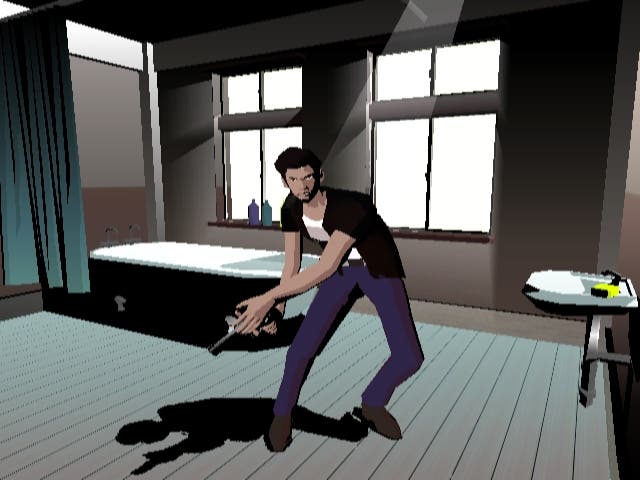
Dotted around you'll find rooms that house the mysterious Samantha (a saucy, sex mad temptress, it seems, not averse to shagging the disabled, we kid you not) as well as a TV set. If Sam is dressed in a nurse's uniform you can save your progress (well, obviously), while the TV bizarrely acts as a means of 'changing channels' between personalities, as well as enabling you to power up one of four of the stats of whichever personality you feel is the most deserving. In this sense it's typical Capcom, reminiscent of the power-up systems used in Devil May Cry, Onimusha, and even Haunting Ground most recently. Blood acts as your currency here, so as long as you're killing regularly, you'll soon be able to power up each personality in the usual areas, such as health, weapon, targeting ability and the like.
Although admittedly we had a Capcom representative present to give us helpful hints, the game feels well structured and logical, with plenty of NPCs on hand to dish out background info and hints as to where you should be heading next. In one instance we had to find a Fire Ring in order to light a sequence of candles, another we had to find an emblem to place on a wall to open up a locked section. Later a locked door yielded to a code scribbled down elsewhere. All very Capcom.
But all the while, there's so much going on in terms of the audiovisual style and presentation that feel so completely different that it's a game that can't help but grab your attention. Having seen four of the game's chapters, it's clear that the style changes quite radically as well. At the start it's quite stark, set in a fairly featureless and clinical office environment, but later it switches to sunny outdoor settings and the yet maintains a consistency of style that charms the socks off you. If there's a cooler looking game that's ever been made, then we haven't seen it.
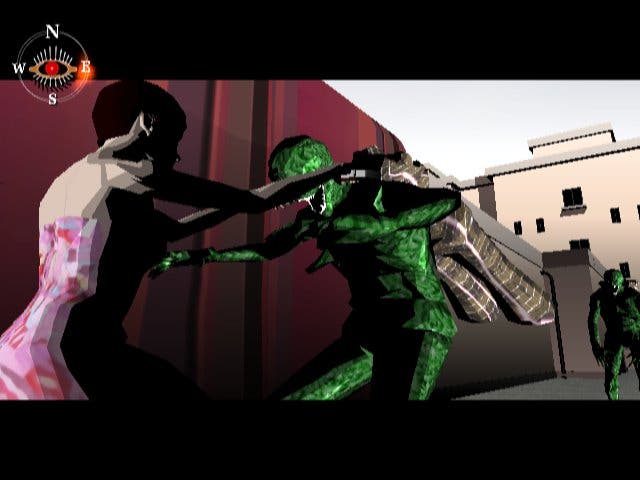
Even the audio is on a different plane. The voice work from all the monstrous creations you come across along the way (the ever-helpful Iwazu and the raspy T-shirt loving Travs, to name but two that we came across) is mostly unintelligible garble. Death-rattling gobbledegook that you'd never understand if it wasn't for the subtitles, while other speak in clearly decipherable English, but not in a way your ears have ever heard it. Truly alien indeed.
But just as charming are the little snatches of guitar work that intersperse little actions, cut-scenes and incidental flourishes. It's like the game's way of providing an audio cue to something impending, and give the game an even richer atmosphere that leaves you beaming from ear to ear at how much loving care has gone into creating something so unlike you've played before, yet has enough solid familiarity to draw you into something with structure and purpose.
With E3 just a few days away, there are going to be one hell of a lot of confused souls who will try to get a hands on during the show and leave the demo pods utterly confused and doubtlessly indifferent to what they've seen. They may shake their head wearily and write it off as an indulgent experiment that's not for them. If that's the case, that's a shame, because in the quiet confines of Capcom's Hammersmith Euro HQ it was quite clear to us that what we have here is a game of immense promise, originality and charm that isn't a game you can just pick up and play and expect to understand or even like for at least the first half hour or so.
All we know is that Killer 7 is one of the only games that will be released this year that is daring to do anything new whatsoever, and deserves your attention on that basis alone. Whether it really does deliver on its promise over the course of the 20-hour game remains to be seen, but its mid-July release is looming large, and we've been promised that we'll be able to get hold of a review copy in the near future.
Check back soon for more on Capcom's great arthouse action-adventure.



